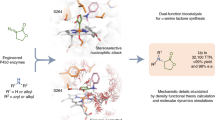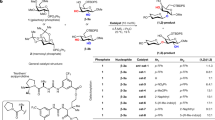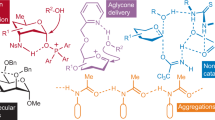Abstract
Enzymes achieve high substrate and product selectivities by orientating and activating the substrate(s) appropriately inside a confined and finely optimized binding pocket. Although some basic aspects of enzymes have already been mimicked successfully with man-made catalysts, substrate activation by proton wires inside enzyme pockets has not been recreated with man-made catalysts so far. A proton wire facilitates the dual activation of a nucleophile and an electrophile via a reciprocal proton transfer, enabling highly stereoselective reactions under mild conditions. Here we present evidence for such an activation mode inside the supramolecular resorcin[4]arene capsule and demonstrate that it enables catalytic and highly β-selective glycosylation reactions—still a major challenge in glycosylation chemistry. Extensive control experiments provide very strong evidence that the reactions take place inside the molecular container. We show that this activation strategy is compatible with a broad scope of glycoside donors and nucleophiles, and is only limited by the cavity size.

This is a preview of subscription content, access via your institution
Access options
Access Nature and 54 other Nature Portfolio journals
Get Nature+, our best-value online-access subscription
$29.99 / 30 days
cancel any time
Subscribe to this journal
Receive 12 print issues and online access
$259.00 per year
only $21.58 per issue
Buy this article
- Purchase on Springer Link
- Instant access to full article PDF
Prices may be subject to local taxes which are calculated during checkout





Similar content being viewed by others
Data availability
The data that support the findings of this study are available in the Supplementary Information (experimental procedures, characterization data, copies of the NMR spectra of novel compounds). The source data for Figs. 1–5 and Table 1 have been deposited on Zenodo (https://zenodo.org/record/6337480#.YidH8ZYo8cQ). Simulation input files for Fig. 4f,g are provided on the PLUMED-NEST repository (https://www.plumed-nest.org/eggs/22/009/).
Change history
19 August 2022
A Correction to this paper has been published: https://doi.org/10.1038/s41557-022-01040-w
References
Kirby, A. J. Enzyme mechanisms, models and mimics. Angew. Chem. Int. Ed. 35, 707–724 (1996).
Motherwell, W. B., Bingham, M. J. & Six, Y. Recent progress in the design and synthesis of artificial enzymes. Tetrahedron 57, 4663–4686 (2001).
Breslow, R. & Dong, S. D. Biomimetic reactions catalyzed by cyclodextrins and their derivatives. Chem. Rev. 98, 1997–2012 (1998).
Hof, F., Craig, S. L., Nuckolls, C. & Rebek, J. J. Molecular encapsulation. Angew. Chem. Int. Ed. 41, 1488–1508 (2002).
Koblenz, T. S., Wassenaar, J. & Reek, J. N. H. Reactivity within a confined self-assembled nanospace. Chem. Soc. Rev. 37, 247–262 (2008).
Rebek, J. Molecular behavior in small spaces. Acc. Chem. Res. 42, 1660–1668 (2009).
Yoshizawa, M., Klosterman, J. K. & Fujita, M. Functional molecular flasks: new properties and reactions within discrete, self-assembled hosts. Angew. Chem. Int. Ed. 48, 3418–3438 (2009).
Wiester, M. J., Ulmann, P. A. & Mirkin, C. A. Enzyme mimics based upon supramolecular coordination chemistry. Angew. Chem. Int. Ed. 50, 114–137 (2011).
Conn, M. M. & Rebek, J. Self-assembling capsules. Chem. Rev. 97, 1647–1668 (1997).
Hong, C. M., Bergman, R. G., Raymond, K. N. & Toste, F. D. Self-assembled tetrahedral hosts as supramolecular catalysts. Acc. Chem. Res. 51, 2447–2455 (2018).
Zhang, Q., Catti, L. & Tiefenbacher, K. Catalysis inside the hexameric resorcinarene capsule. Acc. Chem. Res. 51, 2107–2114 (2018).
Gaeta, C. et al. The hexameric resorcinarene capsule at work: supramolecular catalysis in confined spaces. Chem. Eur. J. 25, 4899–4913 (2019).
Mouarrawis, V., Plessius, R., van der Vlugt, J. I. & Reek, J. N. H. Confinement effects in catalysis using well-defined materials and cages. Front. Chem. https://doi.org/10.3389/fchem.2018.00623 (2018).
Ward, M. D., Hunter, C. A. & Williams, N. H. Coordination cages based on bis(pyrazolylpyridine) ligands: structures, dynamic behavior, guest binding and catalysis. Acc. Chem. Res. 51, 2073–2082 (2018).
Némethová, I., Syntrivanis, L.-D. & Tiefenbacher, K. Molecular capsule catalysis: ready to address current challenges in synthetic organic chemistry? Chimia 74, 561–568 (2020).
Kang, J. & Rebek, J. Acceleration of a Diels–Alder reaction by a self-assembled molecular capsule. Nature 385, 50–52 (1997).
Yoshizawa, M., Tamura, M. & Fujita, M. Diels-Alder in aqueous molecular hosts: unusual regioselectivity and efficient catalysis. Science 312, 251–254 (2006).
Ajami, D. & Rebek, J. More chemistry in small spaces. Acc. Chem. Res. 46, 990–999 (2012).
Leenders, S. H. A. M., Gramage-Doria, R., de Bruin, B. & Reek, J. N. H. Transition metal catalysis in confined spaces. Chem. Soc. Rev. 44, 433–448 (2015).
Raynal, M., Ballester, P., Vidal-Ferran, A. & van Leeuwen, P. W. N. M. Supramolecular catalysis. Part 2: artificial enzyme mimics. Chem. Soc. Rev. 43, 1734–1787 (2014).
Catti, L., Zhang, Q. & Tiefenbacher, K. Advantages of catalysis in self-assembled molecular capsules. Chem. Eur. J. 22, 9060–9066 (2016).
Morimoto, M. et al. Advances in supramolecular host-mediated reactivity. Nat. Catal. 3, 969–984 (2020).
Percástegui, E. G., Ronson, T. K. & Nitschke, J. R. Design and applications of water-soluble coordination cages. Chem. Rev. 120, 13480–13544 (2020).
Frank, R. A. W., Titman, C. M., Pratap, J. V., Luisi, B. F. & Perham, R. N. A molecular switch and proton wire synchronize the active sites in thiamine enzymes. Science 306, 872–876 (2004).
Cukierman, S. Et tu, Grotthuss! and other unfinished stories. Biochim. Biophys. Acta Bioenerg. 1757, 876–885 (2006).
Nakamura, A. et al. ‘Newton’s cradle’ proton relay with amide-imidic acid tautomerization in inverting cellulase visualized by neutron crystallography. Sci. Adv. 1, e1500263 (2015).
MacGillivray, L. R. & Atwood, J. L. A chiral spherical molecular assembly held together by 60 hydrogen bonds. Nature 389, 469–472 (1997).
Shivanyuk, A. & Rebek, J. Reversible encapsulation by self-assembling resorcinarene subunits. Proc. Natl Acad. Sci. USA 98, 7662–7665 (2001).
Avram, L. & Cohen, Y. Spontaneous formation of hexameric resorcinarene capsule in chloroform solution as detected by diffusion NMR. J. Am. Chem. Soc. 124, 15148–15149 (2002).
Avram, L., Cohen, Y. & Rebek, J. Recent advances in hydrogen-bonded hexameric encapsulation complexes. Chem. Commun. 47, 5368–5375 (2011).
Bianchini, G., La Sorella, G., Canever, N., Scarso, A. & Strukul, G. Efficient isonitrile hydration through encapsulation within a hexameric self-assembled capsule and selective inhibition by a photo-controllable competitive guest. Chem. Commun. 49, 5322–5324 (2013).
Cavarzan, A., Scarso, A., Sgarbossa, P., Strukul, G. & Reek, J. N. H. Supramolecular control on chemo- and regioselectivity via encapsulation of (NHC)-Au catalyst within a hexameric self-assembled host. J. Am. Chem. Soc. 133, 2848–2851 (2011).
Zhang, Q. & Tiefenbacher, K. Hexameric resorcinarene capsule is a Brønsted acid: investigation and application to synthesis and catalysis. J. Am. Chem. Soc. 135, 16213–16219 (2013).
Köster, J. M. & Tiefenbacher, K. Elucidating the importance of hydrochloric acid as a cocatalyst for resorcinarene-capsule-catalyzed reactions. ChemCatChem 10, 2941–2944 (2018).
Merget, S., Catti, L., Piccini, G. & Tiefenbacher, K. Requirements for terpene cyclizations inside the supramolecular resorcinarene capsule: bound water and its protonation determine the catalytic activity. J. Am. Chem. Soc. 142, 4400–4410 (2020).
Tanaka, Y., Khare, C., Yonezawa, M. & Aoyama, Y. Highly stereoselective glycosidation of ribose solubilized in apolar organic media via host-guest complexation1. Tetrahedron Lett. 31, 6193–6196 (1990).
Zhu, X. & Schmidt, R. R. New principles for glycoside-bond formation. Angew. Chem. Int. Ed. 48, 1900–1934 (2009).
Nigudkar, S. S. & Demchenko, A. V. Stereocontrolled 1,2-cis glycosylation as the driving force of progress in synthetic carbohydrate chemistry. Chem. Sci. 6, 2687–2704 (2015).
Jensen, K. J. O-Glycosylations under neutral or basic conditions. J. Chem. Soc. Perkin Trans. 1, 2219–2233 (2002).
Davis, B. G. Recent developments in oligosaccharide synthesis. J. Chem. Soc. Perkin Trans. 1, 2137–2160 (2000).
Das, R. & Mukhopadhyay, B. Chemical O-glycosylations: an overview. ChemistryOpen 5, 401–433 (2016).
Ling, J. & Bennett, C. S. Recent developments in stereoselective chemical glycosylation. Asian J. Org. Chem. 8, 802–813 (2019).
Nielsen, M. M. & Pedersen, C. M. Catalytic glycosylations in oligosaccharide synthesis. Chem. Rev. 118, 8285–8358 (2018).
McKay, M. J. & Nguyen, H. M. Recent advances in transition metal-catalyzed glycosylation. ACS Catal. 2, 1563–1595 (2012).
Li, W. & Yu, B. Gold-catalyzed glycosylation in the synthesis of complex carbohydrate-containing natural products. Chem. Soc. Rev. 47, 7954–7984 (2018).
Williams, R. & Galan, M. C. Recent advances in organocatalytic glycosylations. Eur. J. Org. Chem. 2017, 6247–6264 (2017).
Crich, D. Mechanism of a chemical glycosylation reaction. Acc. Chem. Res. 43, 1144–1153 (2010).
Adero, P. O., Amarasekara, H., Wen, P., Bohé, L. & Crich, D. The experimental evidence in support of glycosylation mechanisms at the SN1-SN2 interface. Chem. Rev. 118, 8242–8284 (2018).
Park, Y. et al. Macrocyclic bis-thioureas catalyze stereospecific glycosylation reactions. Science 355, 162–166 (2017).
Kwan, E. E., Park, Y., Besser, H. A., Anderson, T. L. & Jacobsen, E. N. Sensitive and accurate 13C kinetic isotope effect measurements enabled by polarization transfer. J. Am. Chem. Soc. 139, 43–46 (2017).
Mukaiyama, T. & Jona, H. Glycosyl fluoride A superb glycosyl donor in glycosylation. Proc. Jpn. Acad. B Phys. Biol. Sci. 78, 73–83 (2002).
Gerkensmeier, T. et al. Self-assembly of 2,8,14,20-tetraisobutyl-5,11,17,23-tetrahydroxyresorc[4]arene. Eur. J. Org. Chem. 8, 2257–2262 (1999).
Zhang, Q., Catti, L., Kaila, V. R. I. & Tiefenbacher, K. To catalyze or not to catalyze: elucidation of the subtle differences between the hexameric capsules of pyrogallolarene and resorcinarene. Chem. Sci. 8, 1653–1657 (2017).
Crich, D. & Chandrasekera, N. S. Mechanism of 4,6-O-benzylidene-directed β-mannosylation as determined by α-deuterium kinetic isotope effects. Angew. Chem. Int. Ed. 43, 5386–5389 (2004).
Matsui, H., Blanchard, J. S., Brewer, C. F. & Hehre, E. J. α-Secondary tritium kinetic isotope effects for the hydrolysis of α-D-glucopyranosyl fluoride by exo-α-glucanases. J. Biol. Chem. 264, 8714–8716 (1989).
Chan, J., Sannikova, N., Tang, A. & Bennet, A. J. Transition-state structure for the quintessential SN2 reaction of a carbohydrate: reaction of α-glucopyranosyl fluoride with azide ion in water. J. Am. Chem. Soc. 136, 12225–12228 (2014).
Slovak, S. & Cohen, Y. The effect of alcohol structures on the interaction mode with the hexameric capsule of resorcin[4]arene. Chem. Eur. J. 18, 8515–8520 (2012).
Wang, K. et al. Electrostatic control of macrocyclization reactions within nanospaces. J. Am. Chem. Soc. 141, 6740–6747 (2019).
Cai, X., Kataria, R. & Gibb, B. C. Intrinsic and extrinsic control of the pKa of thiol guests inside yoctoliter containers. J. Am. Chem. Soc. 142, 8291–8298 (2020).
Barducci, A., Bussi, G. & Parrinello, M. Well-tempered metadynamics: a smoothly converging and tunable free-energy method. Phys. Rev. Lett. 100, 020603 (2008).
Grifoni, E., Piccini, G. & Parrinello, M. Microscopic description of acid-base equilibrium. Proc. Natl Acad. Sci. USA 116, 4054–4057 (2019).
La Manna, P. et al. Mild Friedel-Crafts reactions inside a hexameric resorcinarene capsule: C-Cl bond activation through hydrogen bonding to bridging water molecules. Angew. Chem. Int. Ed. 57, 5423–5428 (2018).
Grifoni, E., Piccini, G. & Parrinello, M. Microscopic description of acid-base equilibrium. Proc. Natl Acad. Sci. USA 116, 4054–4057 (2019).
Doubleday, C., Bolton, K. & Hase, W. L. Direct dynamics quasiclassical trajectory study of the thermal stereomutations of cyclopropane. J. Phys. Chem. A 102, 3648–3658 (1998).
Xu, L., Doubleday, C. E. & Houk, K. N. Dynamics of 1,3-dipolar cycloadditions: energy partitioning of reactants and quantitation of synchronicity. J. Am. Chem. Soc. 132, 3029–3037 (2010).
Fu, Y., Bernasconi, L. & Liu, P. Ab initio molecular dynamics simulations of the SN1/SN2 mechanistic continuum in glycosylation reactions. J. Am. Chem. Soc. 143, 1577–1589 (2021).
Xu, L., Doubleday, C. E. & Houk, K. N. Dynamics of 1,3-dipolar cycloaddition reactions of diazonium betaines to acetylene and ethylene: bending vibrations facilitate reaction. Angew. Chem. Int. Ed. 48, 2746–2748 (2009).
Jiménez-Osés, G., Liu, P., Matute, R. A. & Houk, K. N. Competition between concerted and stepwise dynamics in the triplet di-π-methane rearrangement. Angew. Chem. Int. Ed. 53, 8664–8667 (2014).
Baldwin, J. E. & Fleming, R. H. Allene-olefin and allene-allene cycloadditions methylenecyclobutane and 1,2-dimethylenecyclobutane degenerate rearrangements. Dynamic Sterochem. https://doi.org/10.1007/BFb0050819 (2006).
Patel, A. et al. Dynamically complex [6 + 4] and [4 + 2] cycloadditions in the biosynthesis of spinosyn A. J. Am. Chem. Soc. 138, 3631–3634 (2016).
Venkatasubban, K. S. & Schowen, R. L. The proton inventory technique. Crit. Rev. Biochem. Mol. Biol. 17, 1–44 (1984).
Schowen, R. L. The use of solvent isotope effects in the pursuit of enzyme mechanisms. J. Labelled Compd Radiopharm. 50, 1052–1062 (2007).
Bennett, C. S. & Galan, M. C. Methods for 2-deoxyglycoside synthesis. Chem. Rev. 118, 7931–7985 (2018).
Yao, H., Vu, M. D. & Liu, X.-W. Recent advances in reagent-controlled stereoselective/stereospecific glycosylation. Carbohydr. Res. 473, 72–81 (2019).
Singh, M. K., Jayaraman, N., Rao, D. S. S. & Prasad, S. K. Effect of the C-2 hydroxyl group on the mesomorphism of alkyl glycosides: synthesis and thermotropic behavior of alkyl 2-deoxy-d-arabino-hexopyranosides. Chem. Phys. Lipids 155, 90–97 (2008).
Marino-Albernas, J. R., Bittman, R., Peters, A. & Mayhew, E. Synthesis and growth inhibitory properties of glycosides of 1-O-hexadecyl-2-O-methyl-sn-glycerol, analogs of the antitumor ether lipid ET-18-OCH3 (Edelfosine). J. Med. Chem. 39, 3241–3247 (1996).
Acknowledgements
This work was supported by the Swiss National Science Foundation as part of the NCCR Molecular Systems Engineering. We thank M. Pfeffer for HR-MS analysis and T. R. Ward for helpful discussions. Molecular dynamics calculations were carried out on the ETH Zurich cluster Euler.
Author information
Authors and Affiliations
Contributions
K.T. conceived and supervised the project. K.T. and T.-R.L. planned the project. T.-R.L. carried out all the experiments except the mechanistic investigations concerning SKIE and reaction order, which were performed by F.H. T.-R.L. and K.T. compiled the first draft of the manuscript. G.M.P. conceived and modelled the simulation of the system, carried out the simulations, interpreted the results, and wrote the first draft of the molecular dynamics section. All authors contributed to the final version of the manuscript.
Corresponding author
Ethics declarations
Competing interests
The authors declare no competing interests.
Peer review
Peer review information
Nature Chemistry thanks Alessandro Laio and the other, anonymous, reviewer(s) for their contribution to the peer review of this work.
Additional information
Publisher’s note Springer Nature remains neutral with regard to jurisdictional claims in published maps and institutional affiliations.
Supplementary information
Supplementary Information
Supplementary experimental details, Figs. 1–18 and schemes 1–9.
Rights and permissions
Springer Nature or its licensor holds exclusive rights to this article under a publishing agreement with the author(s) or other rightsholder(s); author self-archiving of the accepted manuscript version of this article is solely governed by the terms of such publishing agreement and applicable law.
About this article
Cite this article
Li, TR., Huck, F., Piccini, G. et al. Mimicry of the proton wire mechanism of enzymes inside a supramolecular capsule enables β-selective O-glycosylations. Nat. Chem. 14, 985–994 (2022). https://doi.org/10.1038/s41557-022-00981-6
Received:
Accepted:
Published:
Issue Date:
DOI: https://doi.org/10.1038/s41557-022-00981-6
This article is cited by
-
Electrochemical carbon–carbon coupling with enhanced activity and racemate stereoselectivity by microenvironment regulation
Nature Communications (2023)
-
Hopping protons in supramolecular catalysis
Nature Chemistry (2022)



